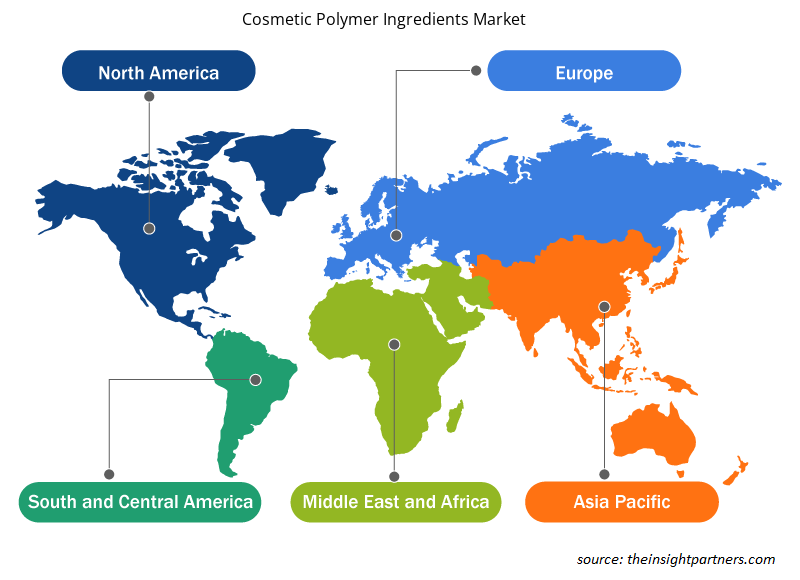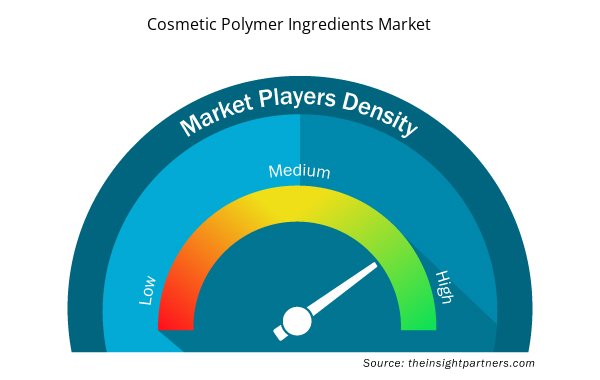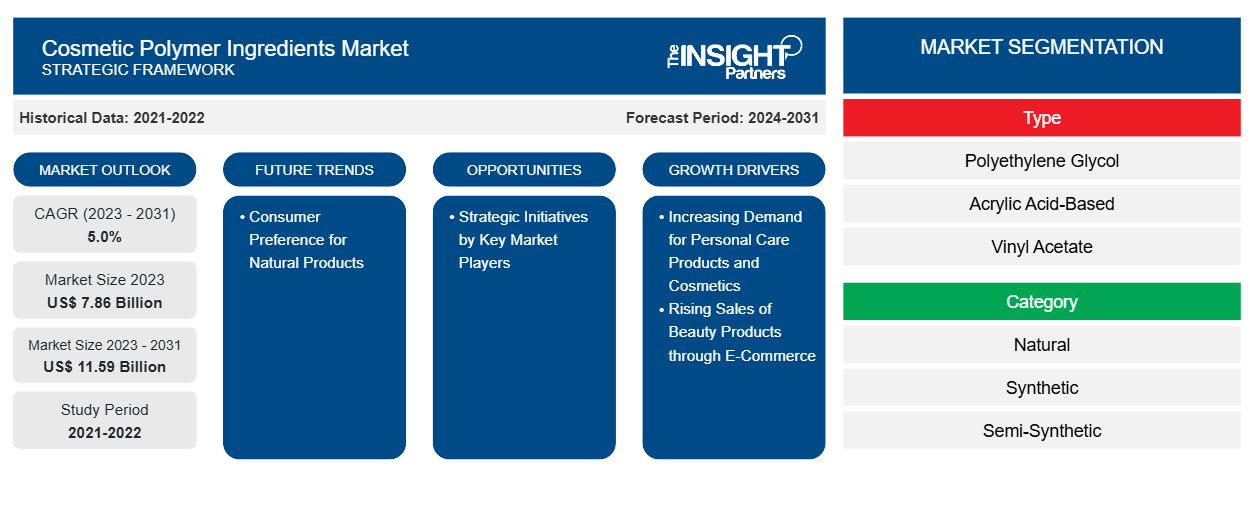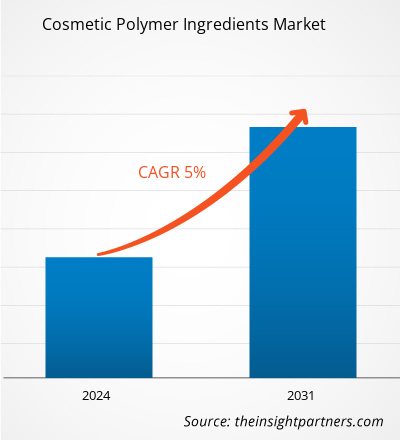化妆品聚合物成分市场规模预计将从 2023 年的 78.6 亿美元增至 2031 年的 115.9 亿美元;预计 2023-2031 年期间市场复合年增长率将达到 5.0%。消费者对天然产品的偏好日益增加,预计将成为市场的一个主要趋势。
化妆品聚合物成分市场分析
欧洲消费者越来越重视美容趋势、时尚、媒体和名人文化。根据欧洲化妆品 - 个人护理协会的数据,2022 年欧洲个人护理和化妆品市场价值约为 940 亿美元。个人护理和化妆品行业为欧洲经济贡献了约 300 亿美元。根据化妆品、盥洗用品和香水协会的数据,2023 年,德国在欧洲个人护理和化妆品市场中占据最大的收入份额。聚合物是化妆品配方开发必不可少的大分子,因为它们能够改变流变性并提供稳定性。因此,对个人护理和化妆品的需求不断增长,推动了化妆品聚合物成分市场的增长。
化妆品聚合物成分市场概览
聚合物通常用于各种个人护理和化妆品中。这些聚合物为个人护理和化妆品配方带来独特的益处。其特性范围与所用聚合物的种类一样多种多样。化妆品中使用的几种常见聚合物类型包括聚乙二醇、丙烯酸基、醋酸乙烯酯、硅酮、纤维素、胶原蛋白、果胶、黄原胶和壳聚糖。
定制此报告以满足您的需求
您可以免费定制任何报告,包括本报告的部分内容、国家级分析、Excel 数据包,以及为初创企业和大学提供优惠和折扣
- 获取此报告的关键市场趋势。这个免费样品将包括数据分析,从市场趋势到估计和预测。
化妆品聚合物成分市场驱动因素和机遇
电子商务推动美容产品销量增长,促进市场增长
电子商务的出现改变了人们购买美容产品的购物体验。智能手机和互联网的迅速普及、 消费者购买力的不断提高、新兴技术的普及以及在线零售购物平台提供的便利,正在推动电子商务行业的发展。根据美国商务部人口普查局的数据,2024 年第一季度美国零售电子商务的销售额经季节性调整后估计为 2892 亿美元,比 2023 年第四季度的销售额增长 2.1%。随着电子商务行业的蓬勃发展,美容产品的消费量也在增长。因此,通过在线销售渠道销售美容产品的增长推动了化妆品聚合物成分市场的发展。
主要市场参与者为创造增长机会而采取的战略举措
化妆品聚合物成分市场的主要制造商正在大力投资战略发展计划,例如产品创新、研发、并购和业务扩展,以吸引广泛的客户群并提升其市场地位。 2023 年 6 月,Solvay SA 宣布推出 Naternal,这是一种生物基可生物降解聚合物,用于可生物降解的自设计护发和护肤 解决方案。 此外,2023 年 10 月,巴斯夫 SE 宣布了其投资计划,将在其杜塞尔多夫工厂开始生产化妆品成分。 这座新工厂预计将生产用于护肤和防晒产品的润肤剂,预计将于 2025 年开始运营。 因此,预计在预测期内,主要市场参与者收购其他企业、推出创新产品和扩大现有生产能力的此类战略举措将在化妆品聚合物成分市场创造丰厚的机会。
化妆品聚合物成分市场报告细分分析
有助于得出化妆品聚合物成分市场分析的关键部分是类型、类别、功能和应用。
- 根据类型,市场细分为聚乙二醇、丙烯酸基、醋酸乙烯酯、硅酮、纤维素、胶原蛋白、果胶、黄原胶、壳聚糖等。2023 年,硅酮部分占据了市场主导地位。
- 根据类别,市场分为天然、合成和半合成。合成部分在 2023 年占据了市场主导地位。
- 根据功能,市场分为流变改性剂、稳定剂、乳化剂、成膜剂、调理剂等。流变改性剂细分市场在 2023 年占据了市场主导地位。
- 根据用途,市场分为护肤品、护发品、化妆品和其他。护肤品在 2023 年占据了市场主导地位。
化妆品聚合物成分市场份额(按地区)分析
化妆品聚合物成分市场报告的地理范围主要分为五个区域:北美、亚太、欧洲、中东和非洲、南美和中美。
2023 年,亚太地区占据了最大的市场份额,预计在预测期内将实现第二高的复合年增长率。由于人们越来越意识到护发的好处,亚太地区的几个国家对生长精华液、面霜、洗发水和护发素等护发产品产生了巨大的需求。因此,护发产品日益增长的重要性和需求推动了亚太地区化妆品聚合物成分市场的发展。此外,提供个性化皮肤营养解决方案的人工智能 (AI) 和基于物联网的设备的发展预计将提高亚太地区美容和个人护理行业的标准,这可能会在未来有利于化妆品聚合物成分市场。由于电子商务平台的使用越来越多,以及二线和三线城市的最后一英里客户访问,印度美容和化妆品行业在过去几年中已经成熟和扩张。此外,中产阶级的扩大和可支配收入的增加导致该国对高端化妆品的需求巨大。据印度投资局称,由于劳动力成本低、数字基础设施先进、互联网普及率高,印度已成为全球化妆品中心。因此,蓬勃发展的化妆品行业推动了印度对化妆品聚合物成分的需求。
化妆品聚合物成分市场区域洞察
Insight Partners 的分析师已详尽解释了预测期内影响化妆品聚合物成分市场的区域趋势和因素。本节还讨论了北美、欧洲、亚太地区、中东和非洲以及南美和中美洲的化妆品聚合物成分市场细分和地理位置。

- 获取化妆品聚合物成分市场的区域特定数据
化妆品聚合物成分市场报告范围
| 报告属性 | 细节 |
|---|---|
| 2023 年的市场规模 | 78.6亿美元 |
| 2031 年市场规模 | 115.9亿美元 |
| 全球复合年增长率(2023 - 2031) | 5.0% |
| 史料 | 2021-2022 |
| 预测期 | 2024-2031 |
| 涵盖的领域 | 按类型
|
| 覆盖地区和国家 | 北美
|
| 市场领导者和主要公司简介 |
|
化妆品聚合物成分市场参与者密度:了解其对业务动态的影响
化妆品聚合物成分市场正在快速增长,这得益于终端用户需求的不断增长,而这些需求又源于消费者偏好的不断变化、技术进步以及对产品优势的认识不断提高等因素。随着需求的增加,企业正在扩大其产品范围,进行创新以满足消费者的需求,并利用新兴趋势,从而进一步推动市场增长。
市场参与者密度是指在特定市场或行业内运营的企业或公司的分布情况。它表明相对于给定市场空间的规模或总市场价值,有多少竞争对手(市场参与者)存在于该市场空间中。
在化妆品聚合物成分市场运营的主要公司有:
- 瑞士联邦通讯委员会
- 嘉吉公司
- 陶氏化学公司
- 巴斯夫
- 赢创工业集团
- 科莱恩公司
免责声明:上面列出的公司没有按照任何特定顺序排列。

- 获取化妆品聚合物成分市场顶级关键参与者概览
化妆品聚合物成分市场新闻和最新发展
化妆品聚合物成分市场通过收集一级和二级研究后的定性和定量数据进行评估,其中包括重要的公司出版物、协会数据和数据库。以下列出了化妆品聚合物成分市场的一些发展情况:
- 科莱恩股份公司宣布以 8.1 亿美元的企业价值 (EV) 从 IFF 收购化妆品和个人护理行业高价值成分供应商 Lucas Meyer Cosmetics。此次收购使科莱恩股份公司能够巩固其市场地位。(科莱恩,公司网站/新闻,2024 年)
- 路博润公司宣布在中国上海开设美容研究院。该中心是进一步发展体内美容测试能力的战略中心,应用决策科学来开发下一代美容成分,增强创新协作,并加快路博润全球美容和个人护理客户的产品上市速度。(路博润公司,公司网站/新闻,2024 年)
- 巴斯夫 SE 宣布扩大其杜塞尔多夫工厂的化妆品成分生产能力。这家新工厂预计将于 2025 年开始运营,生产用于护肤和防晒产品的润肤剂。(巴斯夫,公司网站/新闻,2023 年)
化妆品聚合物成分市场报告覆盖范围和交付成果
“化妆品聚合物成分市场规模和预测(2021-2031)”报告对市场进行了详细分析,涵盖以下领域:
- 化妆品聚合物成分市场规模及范围内所有主要细分市场的预测
- 化妆品聚合物成分市场趋势,以及驱动因素、限制因素和关键机遇等市场动态
- 详细的波特五力分析和 SWOT 分析
- 化妆品聚合物成分市场分析涵盖主要市场趋势、国家框架、主要参与者、法规和最新的市场发展。
- 行业格局和竞争分析,涵盖市场集中度、热图分析、知名参与者以及化妆品聚合物成分市场的最新发展
- 详细的公司简介
- 历史分析(2 年)、基准年、预测(7 年)及复合年增长率
- PEST 和 SWOT 分析
- 市场规模价值/数量 - 全球、区域、国家
- 行业和竞争格局
- Excel 数据集



Report Coverage
Revenue forecast, Company Analysis, Industry landscape, Growth factors, and Trends

Segment Covered
This text is related
to segments covered.

Regional Scope
North America, Europe, Asia Pacific, Middle East & Africa, South & Central America

Country Scope
This text is related
to country scope.
常见问题
The silicone segment held the largest share of the global cosmetic polymer ingredients market in 2023. Silicones are synthetic ingredients manufactured from silicon, and they are available in the form of oils and gels with a nearly thick texture. They are broadly used in cosmetics due to their high stability, water repellency, and spreadability.
Some of the key players in the cosmetic polymer ingredients market include SNF, Cargill Incorporated, The Dow Chemical Co, BASF SE, Evonik Industries AG, Clariant AG, Ashland Inc, Solvay SA, Arkema SA, Nouryon Chemicals Holding BV, Sensient Technologies Corp, The Lubrizol Corporation, SOPHIM IBERIA S.L., Derypol, and 3V Sigma S.p.A.
The market is expected to register a CAGR of 5.0% during 2023–2031.
The rising consumer preference for natural products is expected to be a key trend in the market.
The increasing demand for personal care products and cosmetics, and the rising sales of beauty products through e-commerce are driving the market.
In 2023, Asia Pacific held the largest share of the cosmetic polymer ingredients market. The growing importance and demand for haircare products drive the cosmetic polymer ingredients market in Asia Pacific.
Trends and growth analysis reports related to Chemicals and Materials : READ MORE..
The List of Companies - Cosmetic Polymer Ingredients Market
- SNF
- Cargill Incorporated
- The Dow Chemical Co
- BASF SE
- Evonik Industries AG
- Clariant AG
- Ashland Inc
- Solvay SA
- Arkema SA
- Nouryon Chemicals Holding BV
- Sensient Technologies Corp
- The Lubrizol Corporation
- SOPHIM IBERIA S.L.
- Derypol
- 3V Sigma S.p.A.
The Insight Partners performs research in 4 major stages: Data Collection & Secondary Research, Primary Research, Data Analysis and Data Triangulation & Final Review.
- Data Collection and Secondary Research:
As a market research and consulting firm operating from a decade, we have published and advised several client across the globe. First step for any study will start with an assessment of currently available data and insights from existing reports. Further, historical and current market information is collected from Investor Presentations, Annual Reports, SEC Filings, etc., and other information related to company’s performance and market positioning are gathered from Paid Databases (Factiva, Hoovers, and Reuters) and various other publications available in public domain.
Several associations trade associates, technical forums, institutes, societies and organization are accessed to gain technical as well as market related insights through their publications such as research papers, blogs and press releases related to the studies are referred to get cues about the market. Further, white papers, journals, magazines, and other news articles published in last 3 years are scrutinized and analyzed to understand the current market trends.
- Primary Research:
The primarily interview analysis comprise of data obtained from industry participants interview and answers to survey questions gathered by in-house primary team.
For primary research, interviews are conducted with industry experts/CEOs/Marketing Managers/VPs/Subject Matter Experts from both demand and supply side to get a 360-degree view of the market. The primary team conducts several interviews based on the complexity of the markets to understand the various market trends and dynamics which makes research more credible and precise.
A typical research interview fulfils the following functions:
- Provides first-hand information on the market size, market trends, growth trends, competitive landscape, and outlook
- Validates and strengthens in-house secondary research findings
- Develops the analysis team’s expertise and market understanding
Primary research involves email interactions and telephone interviews for each market, category, segment, and sub-segment across geographies. The participants who typically take part in such a process include, but are not limited to:
- Industry participants: VPs, business development managers, market intelligence managers and national sales managers
- Outside experts: Valuation experts, research analysts and key opinion leaders specializing in the electronics and semiconductor industry.
Below is the breakup of our primary respondents by company, designation, and region:

Once we receive the confirmation from primary research sources or primary respondents, we finalize the base year market estimation and forecast the data as per the macroeconomic and microeconomic factors assessed during data collection.
- Data Analysis:
Once data is validated through both secondary as well as primary respondents, we finalize the market estimations by hypothesis formulation and factor analysis at regional and country level.
- Macro-Economic Factor Analysis:
We analyse macroeconomic indicators such the gross domestic product (GDP), increase in the demand for goods and services across industries, technological advancement, regional economic growth, governmental policies, the influence of COVID-19, PEST analysis, and other aspects. This analysis aids in setting benchmarks for various nations/regions and approximating market splits. Additionally, the general trend of the aforementioned components aid in determining the market's development possibilities.
- Country Level Data:
Various factors that are especially aligned to the country are taken into account to determine the market size for a certain area and country, including the presence of vendors, such as headquarters and offices, the country's GDP, demand patterns, and industry growth. To comprehend the market dynamics for the nation, a number of growth variables, inhibitors, application areas, and current market trends are researched. The aforementioned elements aid in determining the country's overall market's growth potential.
- Company Profile:
The “Table of Contents” is formulated by listing and analyzing more than 25 - 30 companies operating in the market ecosystem across geographies. However, we profile only 10 companies as a standard practice in our syndicate reports. These 10 companies comprise leading, emerging, and regional players. Nonetheless, our analysis is not restricted to the 10 listed companies, we also analyze other companies present in the market to develop a holistic view and understand the prevailing trends. The “Company Profiles” section in the report covers key facts, business description, products & services, financial information, SWOT analysis, and key developments. The financial information presented is extracted from the annual reports and official documents of the publicly listed companies. Upon collecting the information for the sections of respective companies, we verify them via various primary sources and then compile the data in respective company profiles. The company level information helps us in deriving the base number as well as in forecasting the market size.
- Developing Base Number:
Aggregation of sales statistics (2020-2022) and macro-economic factor, and other secondary and primary research insights are utilized to arrive at base number and related market shares for 2022. The data gaps are identified in this step and relevant market data is analyzed, collected from paid primary interviews or databases. On finalizing the base year market size, forecasts are developed on the basis of macro-economic, industry and market growth factors and company level analysis.
- Data Triangulation and Final Review:
The market findings and base year market size calculations are validated from supply as well as demand side. Demand side validations are based on macro-economic factor analysis and benchmarks for respective regions and countries. In case of supply side validations, revenues of major companies are estimated (in case not available) based on industry benchmark, approximate number of employees, product portfolio, and primary interviews revenues are gathered. Further revenue from target product/service segment is assessed to avoid overshooting of market statistics. In case of heavy deviations between supply and demand side values, all thes steps are repeated to achieve synchronization.
We follow an iterative model, wherein we share our research findings with Subject Matter Experts (SME’s) and Key Opinion Leaders (KOLs) until consensus view of the market is not formulated – this model negates any drastic deviation in the opinions of experts. Only validated and universally acceptable research findings are quoted in our reports.
We have important check points that we use to validate our research findings – which we call – data triangulation, where we validate the information, we generate from secondary sources with primary interviews and then we re-validate with our internal data bases and Subject matter experts. This comprehensive model enables us to deliver high quality, reliable data in shortest possible time.


 获取此报告的免费样本
获取此报告的免费样本